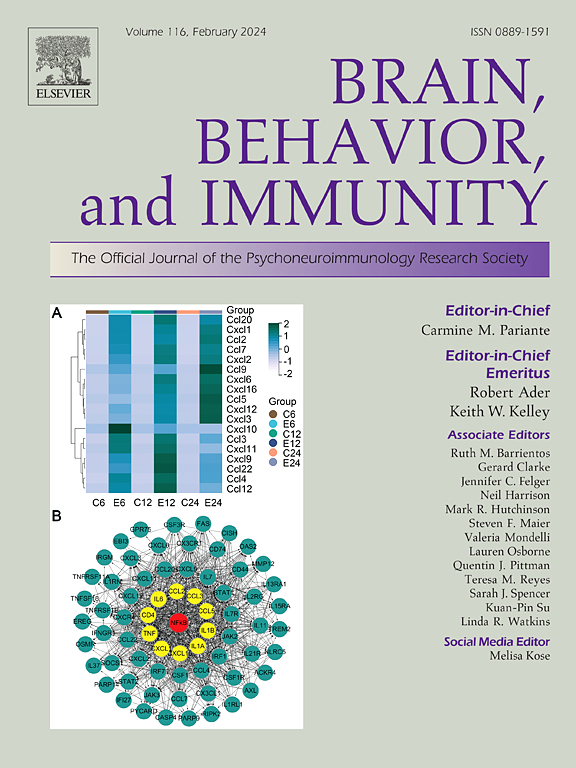Differential effects of social versus monetary incentives on inhibitory control under acute inflammation
IF 8.8
2区 医学
Q1 IMMUNOLOGY
引用次数: 0
Abstract
While the impact of chronic, low-grade inflammation on cognitive functioning is documented in the context of neurodegenerative disease, less is known about the association between acute increases in inflammation and cognitive functioning in daily life. This study investigated how changes in interleukin-6 (IL-6) levels were associated with performance on an inhibitory control task, the go/no-go task. We further examined whether the opportunity to earn different incentive types (social or monetary) and magnitudes (high or low) was associated with differential performance on the task, depending on IL-6 levels. Using a within-participant design, individuals completed an incentivized go/no-go task before and after receiving the annual influenza vaccine. Multilevel logistic regressions were performed on the trial-level data (Nobs = 30,528). For no-go trials, we did not find significant associations in IL-6 reactivity and changes in trial accuracy between sessions. For go trials, we found significant differences in the associations between IL-6 reactivity and changes in accuracy as a function of the incentive condition. Notably, greater IL-6 reactivity was consistently associated with fewer omission errors (i.e., greater accuracy on go trials) on high-magnitude social incentives (i.e., viewing a picture of a close-other) when compared to both low-magnitude social and high-magnitude monetary incentives. Together, these results suggest that mild fluctuations in inflammation might alter the valuation of an incentive, and possibly a shift toward devoting greater attentional resources when a large social incentive is on the line. Overall, this study sheds light on how everyday, low-grade fluctuations in inflammation may influence cognitive abilities essential for daily life and effective inhibitory control.
在急性炎症情况下,社会激励与金钱激励对抑制控制的不同影响。
在神经退行性疾病中,慢性、低度炎症对认知功能的影响已被证实,但人们对炎症的急性增加与日常生活中认知功能之间的关系却知之甚少。本研究调查了白细胞介素-6(IL-6)水平的变化与抑制性控制任务(去/不去任务)的表现之间的关系。我们还进一步研究了获得不同激励类型(社会或金钱)和激励程度(高或低)的机会是否会因白细胞介素-6水平的不同而与任务中的不同表现有关。在接种年度流感疫苗之前和之后,受试者完成了 "去/不去 "任务。我们对试验水平数据(Nobs = 30,528)进行了多层次逻辑回归。对于 "不去 "试验,我们没有发现 IL 和 6 反应性与试验准确性变化之间存在显著关联。而对于 "开始 "试验,我们发现 IL 和 6 反应性与准确率的变化之间存在显著差异,这与激励条件有关。值得注意的是,与低强度的社交激励和高强度的金钱激励相比,在高强度的社交激励条件下(即观看一张近距离的图片),IL-6反应性越高,遗漏错误越少(即围棋试验的准确性越高)。总之,这些结果表明,炎症的轻微波动可能会改变对激励的评价,并可能在有大量社会激励时转向投入更多的注意力资源。总之,这项研究揭示了炎症的日常低级波动如何影响日常生活和有效抑制控制所必需的认知能力。
本文章由计算机程序翻译,如有差异,请以英文原文为准。
求助全文
约1分钟内获得全文
求助全文
来源期刊
CiteScore
29.60
自引率
2.00%
发文量
290
审稿时长
28 days
期刊介绍:
Established in 1987, Brain, Behavior, and Immunity proudly serves as the official journal of the Psychoneuroimmunology Research Society (PNIRS). This pioneering journal is dedicated to publishing peer-reviewed basic, experimental, and clinical studies that explore the intricate interactions among behavioral, neural, endocrine, and immune systems in both humans and animals.
As an international and interdisciplinary platform, Brain, Behavior, and Immunity focuses on original research spanning neuroscience, immunology, integrative physiology, behavioral biology, psychiatry, psychology, and clinical medicine. The journal is inclusive of research conducted at various levels, including molecular, cellular, social, and whole organism perspectives. With a commitment to efficiency, the journal facilitates online submission and review, ensuring timely publication of experimental results. Manuscripts typically undergo peer review and are returned to authors within 30 days of submission. It's worth noting that Brain, Behavior, and Immunity, published eight times a year, does not impose submission fees or page charges, fostering an open and accessible platform for scientific discourse.

 求助内容:
求助内容: 应助结果提醒方式:
应助结果提醒方式:


